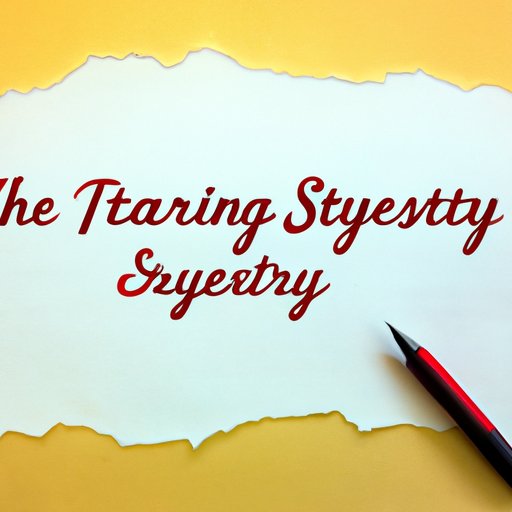
I. Introduction
A strong beginning is essential to capturing a reader’s attention and setting the stage for a successful narrative essay. Whether you’re writing a personal essay or a work of fiction, starting with a hook that engages the reader is crucial. In this article, we’ll explore different strategies for crafting a compelling opening for a narrative essay, as well as common challenges writers face when starting this type of writing project.
II. Start with a hook
Starting with a hook is important because it grabs the reader’s attention and makes them want to keep reading. A hook can be anything from a provocative question to an intriguing statement or anecdote. For example, “It was the summer I turned fourteen, and my life changed forever,” could be an effective hook for a coming-of-age story. When crafting a hook, try to think about what will pique your reader’s curiosity and make them want to learn more.
Brainstorming ideas for a hook can be challenging, but here are some tips to get started:
- Think about your audience and what might interest them
- Consider the tone and theme of your essay
- Try to come up with something unexpected or unique
III. Focus on storytelling
A successful narrative essay is built on the foundation of storytelling. It’s important to start strong because it sets the tone for what’s to come. For example, if you’re writing a personal essay about a challenging experience, you might want to start with a scene that vividly captures the emotions of that moment. Alternatively, you could set the stage with a description that immerses the reader in the world you’re about to create.
When focusing on storytelling, it’s important to keep in mind the key elements of a good story: a protagonist, conflict, and resolution. You want to make sure your opening draws the reader in and makes them care about what happens next.
IV. Offer different options
There are many different ways to begin a narrative essay, and the method you choose will depend on the story you’re trying to tell. Here are some of the most common and effective options:
- Starting in the middle of the action: This can be a great way to immediately engage the reader and create a sense of urgency or excitement.
- Using dialogue: This can be an effective way to establish character and provide insight into relationships and backstory.
- Using description: Describing a scene or setting can help create a vivid picture in the reader’s mind and set the stage for the story to come.
- Offering a provocative statement or question: This can be a powerful way to grab the reader’s attention and make them curious about what comes next.
Here are a few examples:
- “I never believed in ghosts until I moved into my grandmother’s house and heard the creaking stairs every night.” (Starting in the middle of the action)
- “‘I don’t want to die yet,’ I told my mother, even though I knew it was too late.” (Using dialogue)
- “The night sky was a deep shade of blue, and the stars hung like diamonds against the velvet backdrop.” (Using description)
- “Have you ever had a secret that you couldn’t tell anyone? I did, and it was eating me alive.” (Offering a provocative statement or question)
V. Address common challenges
Starting a narrative essay can be challenging, especially if you’re feeling pressure to be original or if you’re struggling to find the right tone. Here are some solutions and tips:
- Don’t worry about being 100% original. It’s okay to use familiar tropes or themes as long as you put your own unique spin on them.
- Experiment with different opening lines or scenes to find the one that works best for your story.
- Don’t be afraid to revise and edit until you feel confident in your opening.
- Read widely in your genre to get a sense of what works and what doesn’t.
VI. Show examples
One of the best ways to learn how to start a narrative essay is to study examples of successful openings. Here are a few examples:
- “It was a bright cold day in April, and the clocks were striking thirteen.” – George Orwell, 1984
- “I am doomed to remember a boy with a wrecked voice—not because of his voice, or because he was the smallest person I ever knew, or even because he was the instrument of my mother’s death, but because he is the reason I believe in God; I am a Christian because of Owen Meany.” – John Irving, A Prayer for Owen Meany
- “All this happened, more or less.” – Kurt Vonnegut, Slaughterhouse-Five
What makes these opening lines effective is that they’re unexpected, intriguing, and immediately establish a tone and setting for the story to come.
VII. Provide a step-by-step guide
To help writers get started on their own narrative essays, here is a step-by-step guide:
- Brainstorm ideas for your essay, including potential opening lines or scenes.
- Choose the one that feels most compelling and start writing.
- Remember to include the key elements of a good story: protagonist, conflict, and resolution.
- Revise and edit until you’re happy with your opening.
VIII. Conclusion
Starting a narrative essay can be challenging, but by following the strategies outlined in this article, writers can craft a strong and engaging opening. Remember to focus on storytelling, experiment with different options, and overcome common challenges by reading, revising, and editing. By starting strong, writers can capture their readers’ attention and set the stage for a compelling narrative.




